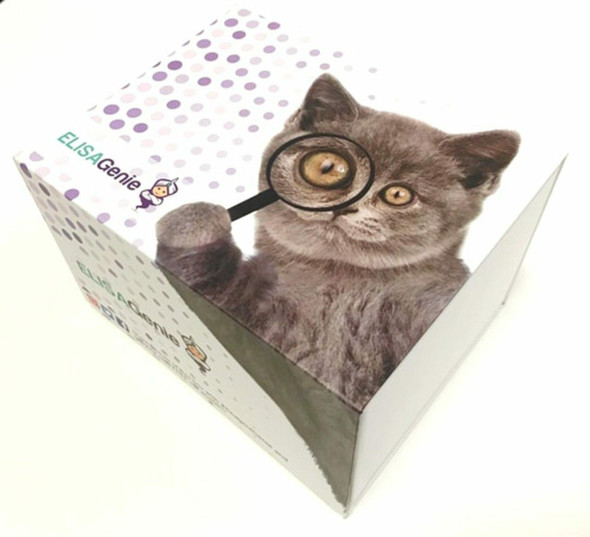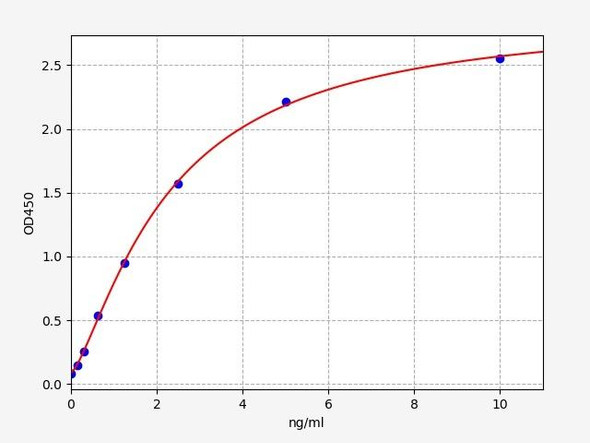Human Cell Biology ELISA Kits 1
Human PEDF(Pigment Epithelium Derived Factor )ELISA Kit (HUES02826)
- SKU:
- HUES02826
- Product Type:
- ELISA Kit
- Size:
- 96 Assays
- Uniprot:
- P36955
- Sensitivity:
- 0.09ng/mL
- Range:
- 0.16-10ng/mL
- ELISA Type:
- Sandwich
- Synonyms:
- SERPINF1, EPC-1, OI12, OI6, PIG35
- Reactivity:
- Human
- Sample Type:
- Serum, plasma and other biological fluids
- Research Area:
- Cell Biology
Description
| Assay type: | Sandwich |
| Format: | 96T |
| Assay time: | 4.5h |
| Reactivity: | Human |
| Detection Method: | Colormetric |
| Detection Range: | 0.16-10 ng/mL |
| Sensitivity: | 0.10 ng/mL |
| Sample Volume Required Per Well: | 100µL |
| Sample Type: | Serum, plasma and other biological fluids |
| Specificity: | This kit recognizes Human PEDF in samples. No significant cross-reactivity or interference between Human PEDF and analogues was observed. |
This ELISA kit uses Sandwich-ELISA as the method. The micro ELISA plate provided in this kit has been pre-coated with an antibody specific to Human PEDF. Standards or samples are added to the appropriate micro ELISA plate wells and combined with the specific antibody. Then a biotinylated detection antibody specific for Human PEDF and Avidin-Horseradish Peroxidase (HRP) conjugate are added to each micro plate well successively and incubated. Free components are washed away. The substrate solution is added to each well. Only those wells that contain Human PEDF, biotinylated detection antibody and Avidin-HRP conjugate will appear blue in color. The enzyme-substrate reaction is terminated by adding Stop Solution and the color turns yellow. The optical density (OD) is measured spectrophotometrically at a wavelength of 450 nm ± 2 nm. The OD value is proportional to the concentration of Human PEDF. The concentration of Human PEDF in samples can be calculated by comparing the OD of the samples to the standard curve.
| UniProt Protein Function: | PEDF: a secreted neurotrophic protein that induces extensive neuronal differentiation in retinoblastoma cells. Potent inhibitor of angiogenesis. As it does not undergo the S (stressed) to R (relaxed) conformational transition characteristic of active serpins, it exhibits no serine protease inhibitory activity. The N-terminal (AA 44-121) exhibits neurite outgrowth-inducing activity. The C-terminal exposed loop (AA 382-418) is essential for serpin activity. Extracellular phosphorylation enhances antiangiogenic activity. |
| UniProt Protein Details: | Protein type:Secreted; Secreted, signal peptide; Inhibitor Chromosomal Location of Human Ortholog: 17p13. 3 Cellular Component: axon hillock; extracellular matrix; extracellular space; perinuclear region of cytoplasm; extracellular region; melanosome; basement membrane Molecular Function:serine-type endopeptidase inhibitor activity Biological Process: cell proliferation; positive regulation of neurogenesis; negative regulation of angiogenesis; ovulation cycle; retina development in camera-type eye; short-term memory; response to arsenic; multicellular organismal development; negative regulation of inflammatory response; response to acidity; kidney development; aging Disease: Osteogenesis Imperfecta, Type Vi |
| NCBI Summary: | The protein encoded by this gene is a member of the serpin family, although it does not display the serine protease inhibitory activity shown by many of the other serpin family members. The encoded protein is secreted and strongly inhibits angiogenesis. In addition, this protein is a neurotrophic factor involved in neuronal differentiation in retinoblastoma cells. [provided by RefSeq, Mar 2011] |
| UniProt Code: | P36955 |
| NCBI GenInfo Identifier: | 313104314 |
| NCBI Gene ID: | 5176 |
| NCBI Accession: | P36955. 4 |
| UniProt Secondary Accession: | P36955,Q13236, Q2TU83, Q96CT1, Q96R01, Q9BWA4, F1T092 |
| UniProt Related Accession: | P36955 |
| Molecular Weight: | 46,312 Da |
| NCBI Full Name: | Pigment epithelium-derived factor |
| NCBI Synonym Full Names: | serpin peptidase inhibitor, clade F (alpha-2 antiplasmin, pigment epithelium derived factor), member 1 |
| NCBI Official Symbol: | SERPINF1 |
| NCBI Official Synonym Symbols: | OI6; OI12; PEDF; EPC-1; PIG35 |
| NCBI Protein Information: | pigment epithelium-derived factor; serpin F1; cell proliferation-inducing gene 35 protein; serine (or cysteine) proteinase inhibitor, clade F (alpha-2 antiplasmin, pigment epithelium derived factor), member 1 |
| UniProt Protein Name: | Pigment epithelium-derived factor |
| UniProt Synonym Protein Names: | Cell proliferation-inducing gene 35 protein; EPC-1; Serpin F1 |
| UniProt Gene Name: | SERPINF1 |
| UniProt Entry Name: | PEDF_HUMAN |
As the OD values of the standard curve may vary according to the conditions of the actual assay performance (e. g. operator, pipetting technique, washing technique or temperature effects), the operator should establish a standard curve for each test. Typical standard curve and data is provided below for reference only.
| Concentration (ng/mL) | O.D | Average | Corrected |
| 10 | 2.182 2.21 | 2.196 | 2.124 |
| 5 | 1.534 1.568 | 1.551 | 1.479 |
| 2.5 | 0.86 0.836 | 0.848 | 0.776 |
| 1.25 | 0.406 0.436 | 0.421 | 0.349 |
| 0.63 | 0.256 0.246 | 0.251 | 0.179 |
| 0.32 | 0.165 0.161 | 0.163 | 0.091 |
| 0.16 | 0.114 0.126 | 0.12 | 0.048 |
| 0 | 0.066 0.078 | 0.072 | -- |
Precision
Intra-assay Precision (Precision within an assay): 3 samples with low, mid range and high level Human PEDF were tested 20 times on one plate, respectively.
Inter-assay Precision (Precision between assays): 3 samples with low, mid range and high level Human PEDF were tested on 3 different plates, 20 replicates in each plate.
| Intra-assay Precision | Inter-assay Precision | |||||
| Sample | 1 | 2 | 3 | 1 | 2 | 3 |
| n | 20 | 20 | 20 | 20 | 20 | 20 |
| Mean (ng/mL) | 0.47 | 0.92 | 4.21 | 0.46 | 0.89 | 4.41 |
| Standard deviation | 0.03 | 0.05 | 0.15 | 0.03 | 0.05 | 0.24 |
| C V (%) | 6.38 | 5.43 | 3.56 | 6.52 | 5.62 | 5.44 |
Recovery
The recovery of Human PEDF spiked at three different levels in samples throughout the range of the assay was evaluated in various matrices.
| Sample Type | Range (%) | Average Recovery (%) |
| Serum (n=5) | 92-103 | 98 |
| EDTA plasma (n=5) | 84-96 | 91 |
| Cell culture media (n=5) | 90-106 | 97 |
Linearity
Samples were spiked with high concentrations of Human PEDF and diluted with Reference Standard & Sample Diluent to produce samples with values within the range of the assay.
| Serum (n=5) | EDTA plasma (n=5) | Cell culture media (n=5) | ||
| 1:2 | Range (%) | 97-112 | 94-110 | 86-99 |
| Average (%) | 104 | 100 | 93 | |
| 1:4 | Range (%) | 88-102 | 81-92 | 82-95 |
| Average (%) | 94 | 86 | 87 | |
| 1:8 | Range (%) | 88-101 | 87-100 | 85-99 |
| Average (%) | 94 | 93 | 91 | |
| 1:16 | Range (%) | 86-101 | 85-99 | 88-103 |
| Average (%) | 93 | 91 | 94 |
An unopened kit can be stored at 4°C for 1 month. If the kit is not used within 1 month, store the items separately according to the following conditions once the kit is received.
| Item | Specifications | Storage |
| Micro ELISA Plate(Dismountable) | 8 wells ×12 strips | -20°C, 6 months |
| Reference Standard | 2 vials | |
| Concentrated Biotinylated Detection Ab (100×) | 1 vial, 120 µL | |
| Concentrated HRP Conjugate (100×) | 1 vial, 120 µL | -20°C(shading light), 6 months |
| Reference Standard & Sample Diluent | 1 vial, 20 mL | 4°C, 6 months |
| Biotinylated Detection Ab Diluent | 1 vial, 14 mL | |
| HRP Conjugate Diluent | 1 vial, 14 mL | |
| Concentrated Wash Buffer (25×) | 1 vial, 30 mL | |
| Substrate Reagent | 1 vial, 10 mL | 4°C(shading light) |
| Stop Solution | 1 vial, 10 mL | 4°C |
| Plate Sealer | 5 pieces | |
| Product Description | 1 copy | |
| Certificate of Analysis | 1 copy |
- Set standard, test sample and control (zero) wells on the pre-coated plate and record theirpositions. It is recommended to measure each standard and sample in duplicate. Note: addall solutions to the bottom of the plate wells while avoiding contact with the well walls. Ensuresolutions do not foam when adding to the wells.
- Aliquot 100µl of standard solutions into the standard wells.
- Add 100µl of Sample / Standard dilution buffer into the control (zero) well.
- Add 100µl of properly diluted sample (serum, plasma, tissue homogenates and otherbiological fluids) into test sample wells.
- Cover the plate with the sealer provided in the kit and incubate for 90 min at 37°C.
- Aspirate the liquid from each well, do not wash. Immediately add 100µL of BiotinylatedDetection Ab working solution to each well. Cover the plate with a plate seal and gently mix. Incubate for 1 hour at 37°C.
- Aspirate or decant the solution from the plate and add 350µL of wash buffer to each welland incubate for 1-2 minutes at room temperature. Aspirate the solution from each well andclap the plate on absorbent filter paper to dry. Repeat this process 3 times. Note: a microplatewasher can be used in this step and other wash steps.
- Add 100µL of HRP Conjugate working solution to each well. Cover with a plate seal andincubate for 30 min at 37°C.
- Aspirate or decant the solution from each well. Repeat the wash process for five times asconducted in step 7.
- Add 90µL of Substrate Reagent to each well. Cover with a new plate seal and incubate forapproximately 15 min at 37°C. Protect the plate from light. Note: the reaction time can beshortened or extended according to the actual color change, but not by more than 30min.
- Add 50 µL of Stop Solution to each well. Note: Adding the stop solution should be done inthe same order as the substrate solution.
- Determine the optical density (OD value) of each well immediately with a microplate readerset at 450 nm.






